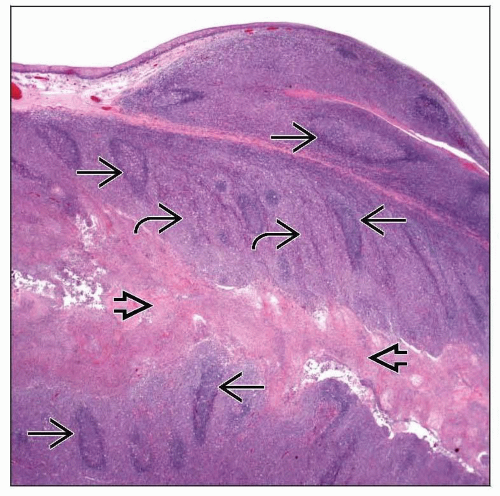Infectious Mononucleosis
Bruce M. Wenig, MD
Key Facts
Terminology
Systemic, benign, self-limiting infectious lymphoproliferative disease primarily caused by, but not limited to, Epstein-Barr virus (EBV) infection
Etiology/Pathogenesis
EBV estimated to cause 80-95% of IM cases
Clinical Issues
May occur in all age groups, but primarily affects adolescents and young adults
Acute pharyngotonsillitis with patients experiencing sore throat, fever, and malaise
Prodromal period of 2-5 days with malaise and fatigue frequently occurs prior to onset of full syndrome
Absolute lymphocytosis with > 50% lymphocytes in total leukocyte population of > 5,000/mm3
Prominent atypical lymphocytes (Downey cells) often > 10% of total leukocyte count
Therapy is supportive, including rest and fluid intake
Microscopic Pathology
Distortion &/or partial effacement of nodal/tonsillar architecture with
Reactive follicular hyperplasia characterized by enlarged and irregularly shaped germinal centers
Expansion of interfollicular areas with polymorphous proliferation of
Small lymphocytes, transformed lymphocytes, immunoblasts, plasma cells, and Reed-Sternberg-like cells
TERMINOLOGY
Abbreviations
Infectious mononucleosis (IM)
Definitions
Systemic, benign, self-limiting infectious lymphoproliferative disease primarily caused by, but not limited to, Epstein-Barr virus (EBV) infection
ETIOLOGY/PATHOGENESIS
Infectious Agents
EBV estimated to cause 80-95% of IM cases
EBV
Enveloped icosahedral herpesvirus with doublestranded linear DNA
Strongly tropic for B lymphocytes
Also tropic for T lymphocytes
Associated with
Oral hairy leukoplakia
NK-/T-cell lymphoma, nasal type
Burkitt lymphoma
Hodgkin lymphoma
Nasopharyngeal-type nonkeratinizing carcinomas (differentiated and undifferentiated)
Virus penetrates nasopharyngeal epithelium and infects B lymphocytes
EBV-infected B-cells proliferate and elicit humoral and cellular immune responses
Other microorganisms associated with mononucleosis-like syndromes include
Cytomegalovirus (CMV)
Toxoplasma gondii
Rubella
Hepatitis A virus
Adenoviruses
CLINICAL ISSUES
Epidemiology
Age
May occur in all age groups, but primarily affects adolescents and young adults
Gender
Equal gender distribution
Site
Tonsils
Presentation
Acute pharyngotonsillitis with patients experiencing sore throat, fever, and malaise
Pharyngotonsillitis often severe and may be exudative
Pharyngitis characterized by marked swollen and enlarged tonsils covered by dirty gray exudates
Lymphadenopathy and hepatosplenomegaly with chemical evidence of hepatitis may represent systemic manifestations of disease
Stay updated, free articles. Join our Telegram channel

Full access? Get Clinical Tree









